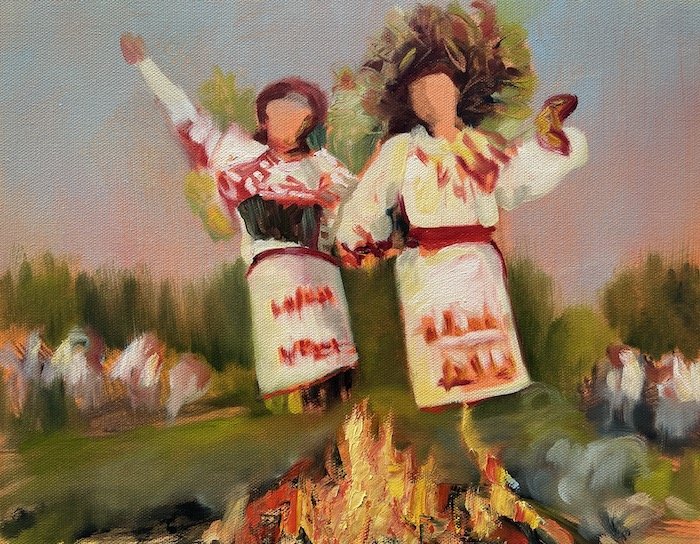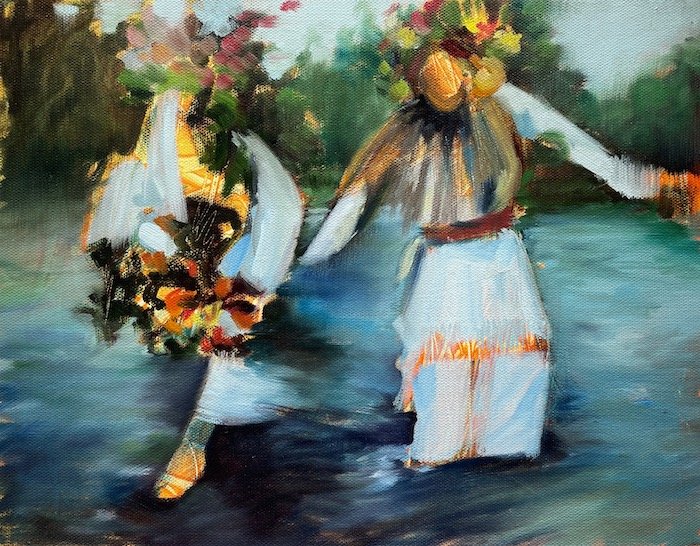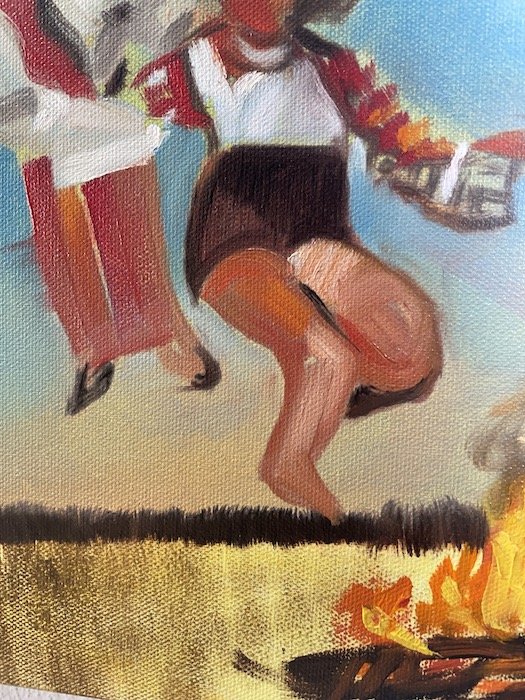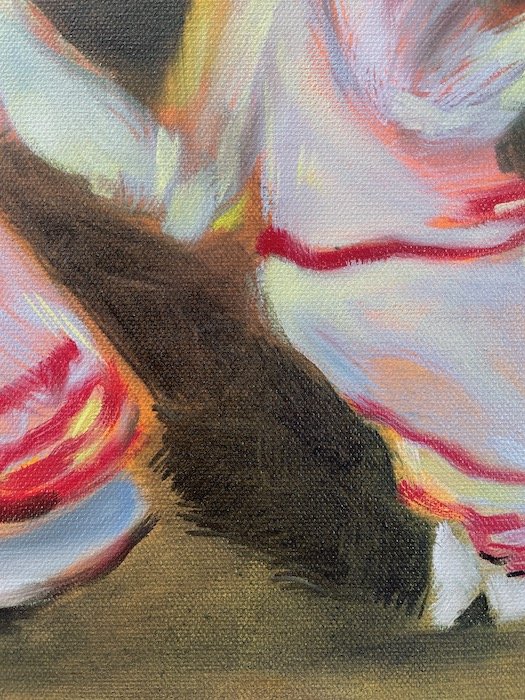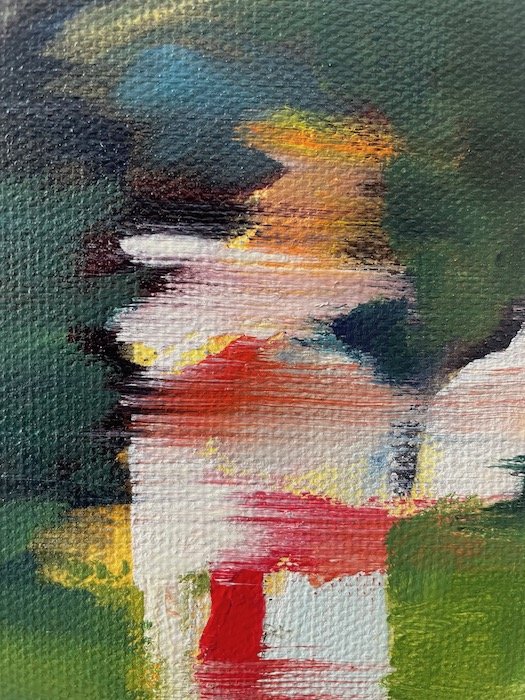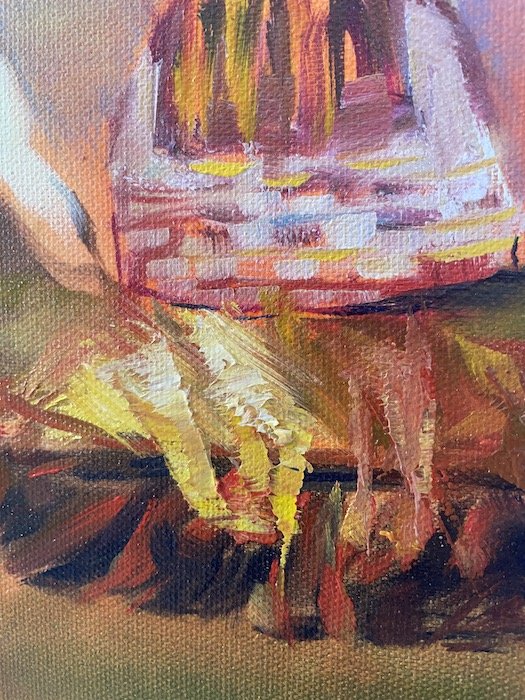“Fireflight” oil on canvas, 11x14 inches, 2023
Co-creation and collaboration
Kelsey Birsa and Tatyana Ostapenko
I am excited to share that my latest painting series, "Me, Myself and AI" will be exhibited at Cambium Gallery in Astoria, Oregon from April 8th through May 8th. This two-artist exhibition will feature contemporary figurative oil paintings by me and Kelsey Birsa.
The gallery's theme for the year is "co-creation," and they are interested in all manner of cooperative creative processes for generating artwork and artists who work in collaborative ways. We were thrilled to receive an invitation to this show. While we occasionally work as a team on murals and enjoy working together, for this show we each created our separate bodies of work. The element of co-creation here was in an ongoing conversation and exploration of the use of AI in generating reference materials for our paintings.
Both Kelsey and I base our painting compositions on photographic collages that we create first. I have an extensive database of over 12,000 images that range from Soviet archival materials to friends' and family photos, to web-sourced memes and social media profile pictures. For this project, I wanted to let go of my tightly curated aesthetic and allow the text-to-image AI generator to provide me with some visual source material.
While Kelsey and I worked separately on our own paintings, we still maintained a dialogue throughout the process. We shared our progress, insights, and challenges with each other, which helped us both to explore new ideas and push ourselves in new directions.
Using AI as a tool in traditional painting
The fascinating thing about using AI for this is that it uses the most averaged-out, common, and frequently used images from around the internet that correspond to the text input. I wanted to know what would happen if I used an English language query to get images of a traditional folk festival common to a few Slavic countries. The festival is called Ivana Kupala and has its roots in pagan traditions that have survived through the last thousand years of Christianization and subsequent repression of the older belief systems and rituals.
Flower Crowns. Oil on canvas. 11x14 inches. 2023
When I played with this sort of AI before, I was somewhat entertained but ultimately bored with the generic images that looked like they all came from a poorly rendered video game preview. Somehow I got so lucky with this particular batch because what I got were deeply moving, mythical, strange, and absurdly distorted images that captured the magic of this special night known for its divination, risk-taking, flirtation, and hope for a transcendent prize.
Tradition, myth-making and memory
Growing up, I was enormously curious about old folk traditions, but didn't have anyone around me who could share that knowledge. My family was all city-dwellers for generations back, and ritual and mystery seemed more suited to survive in the countryside.
So the AI felt like a strange and unlikely medium to conjure up blurry and distorted visions to illustrate my childhood fancy. I know it's just smashing together and averaging out the many contemporary photo shoots that are created out of the same sense of longing and nostalgia for the past that we imagine came before us. Some of it might be based on historical truths, much of it is a distortion of the stories passed through generations. But these stories are what we call tradition and rely upon to create our present sense of self in the world and use as a place to start our thinking about the future.
I thought this medium was quite appropriate to explore contemporary myth-making, remembering old stories, weaving new ideas into them, while the final result will inadvertently be distorted through the lens of our individual perception and our collective conditioning. So I let the AI take care of the collective conditioning, while the imperfections of my rendering provided the personal distortion.
Paintings: style, content, materials
The series is a suite of twelve medium to small-sized paintings, oil on canvas. They are contemporary figurative, semi-abstracted with a touch of impressionistic paint handling. The figures are anonymous, with just a suggestion of facial features, wearing white embroidered shirts and long linen dresses, wading in water, purposefully striding through it, and jumping over bonfires, caught mid-flight over the flames. There are traditional flower crowns, intricately tied head scarves, and a sense of the usually unattainable magic bursting into the mundane world for just one magical night.
The Dance. Oil on canvas. 18x24 inches. 2023
In these paintings, I aimed to capture the essence of the Ivana Cupala festival, using the images generated by the AI as a starting point. I wanted to convey the sense of magic and mystery that permeates this ancient Slavic tradition, while also exploring the ways in which these traditions are being reinterpreted and reimagined in the modern world. I wanted to create a sense of movement and fluidity, capturing the energy and excitement of the festival.
For me, this series is an exploration of the ways in which our collective past can inform and enrich our present, and how our individual perspectives and experiences shape the stories we tell about ourselves and our communities. The use of AI in generating reference materials for these paintings was a new and exciting way to explore this idea, and I'm thrilled with the results.
I hope that viewers of this exhibition will be inspired to explore their own connections to tradition and to reimagine these ancient stories in new and exciting ways. I also hope that this exhibition will encourage more artists to explore the potential of working with AI and other emerging technologies to expand the boundaries of their own creativity and to collaborate with others in new and innovative ways.
"Me, Myself and AI" will be on display at Cambium Gallery in Astoria, Oregon April 8th - May 8th. I hope to see you there!
